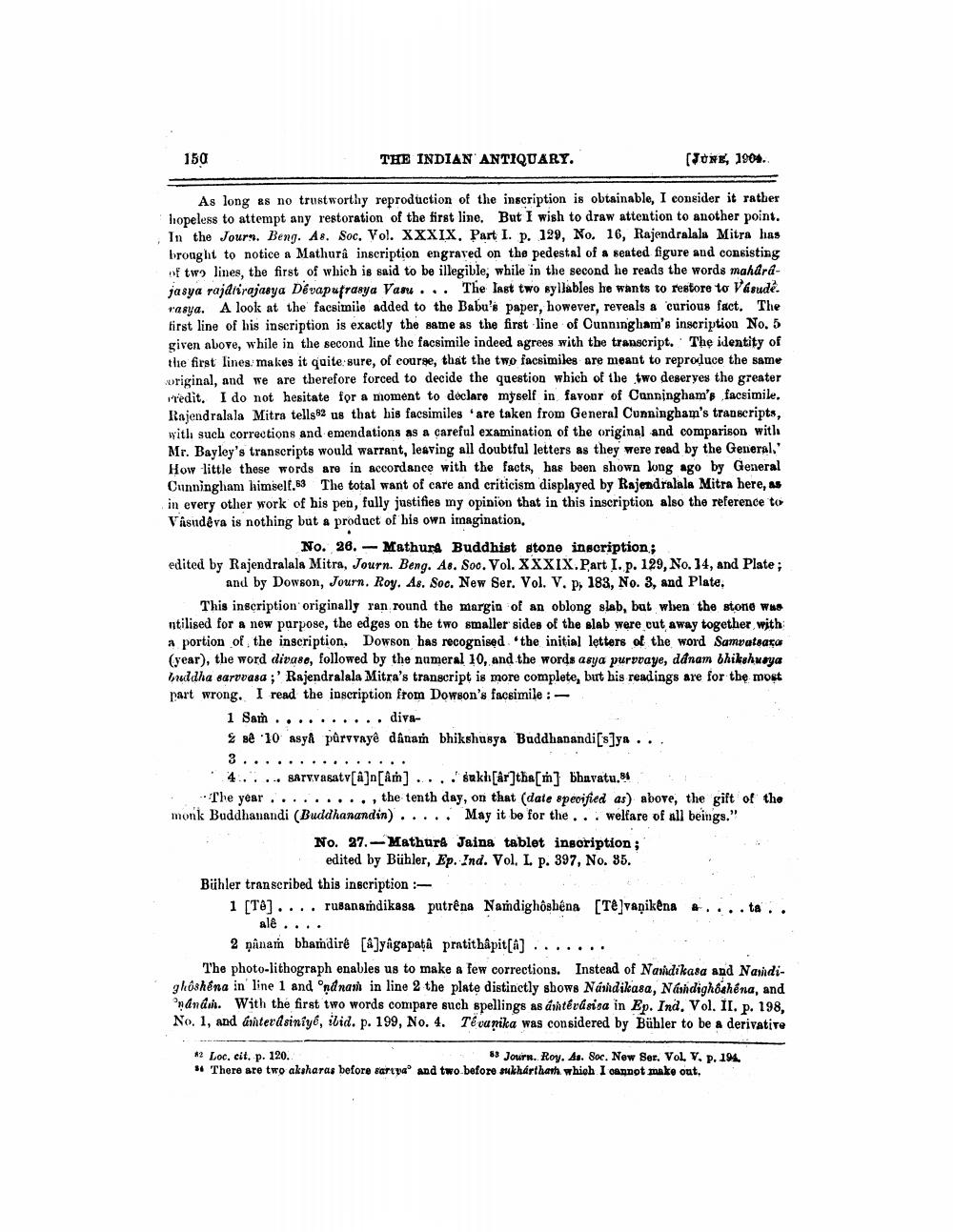________________
150
THE INDIAN ANTIQUARY.
(JUNE, 1904.
As long as no trustworthy reproduction of the inscription is obtainable, I consider it rather hopeless to attempt any restoration of the first line. But I wish to draw attention to another point. In the Jours. Beng. As. Soc. Vol. XXXIX, Part I. p. 129, No. 16, Rajendralala Mitra has brought to notice a Mathura inscription engraved on the pedestal of a seated figure and consisting of two lines, the first of which is said to be illegible, while in the second he reads the words mahardjasya rajdrirajasya Dévapafrasya Varu ... The last two syllables he wants to restore to Vasude. rasya. A look at the facsimile added to the Babu's paper, however, reveals a curious fact. The first line of his inscription is exactly the same as the first line of Cunningham's inscription No. 5 given above, while in the second line the facsimile indeed agrees with the transcript. The identity of the first lines, makes it quite sure, of course, that the two facsimiles are meant to reproduce the same original, and we are therefore forced to decide the question which of the two deseryes the greater Fredit. I do not hesitate for a moment to declare myself in favour of Canningham's facsimile. Rajendralala Mitra tells82 us that his facsimiles are taken from General Cunningham's transcripts, with such corrections and emendations as a careful examination of the original and comparison with Mr. Bayley's transcripts would warrant, leaving all doubtful letters as they were read by the General.' How little these words are in accordance with the facts, has been shown long ago by General Cunningham himself.63 The total want of care and criticism displayed by Rajendralala Mitra here, as in every other work of his pen, fully justifies my opinion that in this inscription also the reference to Vasudeva is nothing but a product of his own imagination,
No. 28.- Mathura Buddhist stone inscription; edited by Rajendralala Mitra, Journ. Beng. As. Soc. Vol. XXXIX. Part I. p. 129, No. 34, and Plate;
and by Dowson, Journ. Roy. As. Soc. New Ser. Vol. V. p, 183, No. 3, and Plate,
This inscription originally ran round the margin of an oblong slab, but when the stone was ntilised for a new purpose, the edges on the two smaller sides of the slab were cut away together with a portion of the inscription. Dowson has recognised the initial letters of the word Samvatsara (year), the word divase, followed by the numeral 10, and the words asya purvaye, dánam bhikshusya bruddha saruvasa ;' Rajendralala Mitra's transcript is more complete, but his readings are for the most part wrong. I read the inscription from Dowson's facsimile:
1 Sam .......... diva2 sê '10 asy& pûrvvayê dânaṁ bhikshusya Buddhanandi[s]ya ...
4..... saruvasatv[]n[Am] .... sakh [ar]the[m] bhavatu.94
The year ........., the tenth day, on that (date specified as) above, the gift of the monk Buddhanandi (Buddhanandin)..... May it be for the ... welfare of all beings."
No. 27. - Mathura Jaina tablet inscription;
edited by Bühler, Ep. Ind. Vol. I. p. 397, No. 85. Bühler transcribed this inscription : 1 [TA).... rusanaṁdikasa putrêna Nandighôshéna [T&]varikếna #....ta.
ale .... 2 pinan bharidire [@]sigpata pratithậpit[4] ...... The photo-lithograph enables us to make a few corrections. Instead of Navdikasa and Naridighoshéna in line 1 and nanan in line 2 the plate distinctly shows Náridikasa, Nándighoshéna, and onana. With the first two words compare such spellings as ártérásisa in Ep. Ind. Vol. II. p. 198, No. 1, and árintevasiniye, ibid. p. 199, No. 4. Té vanika was considered by Bühler to be a derivative
*2 Loc. cit. p. 120.
# Journ. Roy. As. Soc. New Ser. Vol. V, p. 194 # There are two akaharas before sarivao and two before sukharthath which I cannot make out.




